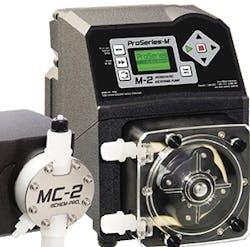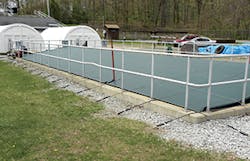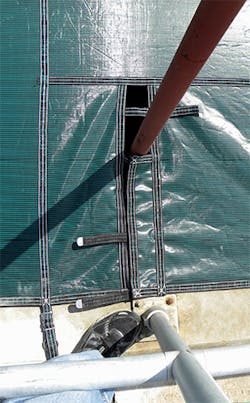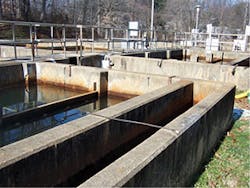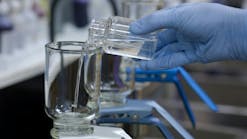Water utility operators face many financial hardships these days. Today, cash-strapped utilities are challenged to deliver optimal levels of service while saving money on water treatment costs.
Treatment costs are not isolated and must be considered as part of the overall cost of water service, points out Brian Bokowy, business manager CIM for AllChem Performance Products. “Water utilities—particularly utilities that have multiple locations and multiple well sites, booster stations, and multiple treatment areas—have all of the logistics of transportation, storage, handling, and safety concerns of securing all of those individual sites,” notes Bokowy.
Oftentimes, safety concerns will dictate more than one employee going out to a site whenever chemicals are being handled, he adds. “All of these additional visits out to sites, all of the additional safety and handling concerns, add real costs to chlorinate that water for the municipality,” says Bokowy.
“By moving to safer, less hazardous chemicals, it reduces costs by eliminating some of the storage concerns, and eliminating some of the extra personnel and trips out to the sites that may be involved with the manhours associated with going out to those sites.”
AllChem Performance Products specializes in chlorination equipment, especially tablet feed systems. The systems are designed as an effective way to chlorinate drinking water and wastewater without the costly safety and hazard concerns associated with handling, transporting, and treating with gas chlorine or liquid chlorine sodium hypochlorite, notes Bokowy.
One system offered by the company is the PTF-100 Feed System, consisting of the Horizon PTF-100 Tablet Feeder and Horizon 90 PT Tablets.
The system is used for treatment of potable water, wastewater, and industrial water applications, including municipal drinking water, wastewater, and surface water chlornation, booster stations, well stations, and remote chlorination sites.
Tablet chlorination systems are designed as a “safer, more effective, and reliable” alternative to gas and liquid chlorine systems with 100% soluble tablets with 90% free available chlorine content for low maintenance, notes Bokowy.
A horizontal spray onto the tablets produces a consistent chlorine residual for system delivery, with tablets only sprayed when chlorine feed is desired to minimize the loss of available chlorine.
As tablets are sprayed, the resulting chlorine solution is collected in the lower basin and delivered to the system with an eductor.
Outlet flow is equal to inlet flow, which is 0.0 to 1.0 or 0.1 to 3.5 gallons per minute, depending on supplied rotameter. The inlet pressure is 10 to 75 psi, with an operating temperature of 30 to 104°F. Tablet capacity is 100 pounds.
“The cost of water is the entire cost,” points out Bokowy. “It’s not just the cost of a pound of chlorine, for example. The cost of the water involves the manpower, the time, the transportation, the maintenance of safety and other equipment, the training required of your personnel on an annual basis to use these chemistries and use them safely at all of those locations. All of those costs are part of the overall cost of supplying water to the community.”
Bokowy advises municipalities and industrial entities that when they are considering new systems or upgrading existing systems that they have to conduct a comprehensive and complete evaluation of all of the costs associated with the system.
“A lot of times, people will look at what they are paying for a pound of chlorine or a gallon of bleach, but they don’t even factor in delivery or fuel service charges that are being charged by the distributor of the company they’re buying the products from,” he says.
“A lot of municipalities overlook those very real overhead costs that they don’t see on a purchase order: the safety equipment, the manhours, the call outs in the middle of the night on overtime, repair of secondary containment dikes for liquid chlorine, chlorine sensors in place for gas chlorine.”
The maintenance and upkeep of that equipment are “very real costs” associated with using the equipment, Bokowy points out.
“Total them up for all of the options you’re considering to get an honest evaluation of what your annual cost is for the different options available for you,” he adds.
Indeed, part of cost-saving water treatment strategies entail the technologies through which the treatment processes are delivered.
Blue-White Industries manufacturers chemical metering pumps, flow instruments, and water treatment accessories for municipal water and wastewater treatment applications, as well as chemical injection, chlorination, and chloramination.
One such cost-saving delivery system is the peristaltic pump, notes Bill McDowell, company sales engineer, adding that the pumps are designed for greater accuracy with its nearly continuous output, in contrast to the intermittent injection operation of a diaphragm metering-style pump.
McDowell points out the difference is that in adjusting the chemical output from a diaphragm pump, one must change its pulses given that there are a number of pulses per minute and injections per minute.
A peristaltic pump enables the operator to pump a chemical such as fluoride through the system in small, nearly continuous amounts, “which gives you a good dispersion of chemical in the flow stream and if you’re monitoring the residual fluoride in the water and monitoring that downstream, you’re typically going to get a much finer reading on the residual than if you were using a diaphragm pump,” notes McDowell.
“A diaphragm pump would be plunging in spurts of chemical instead of a near continuous application. Polymer is another chemical that you want to use the least amount of that you can because it’s very expensive. By turning it down very slow and with a nearly continuous injection, the polymer opens up and it’s a good dispersion of chemical in the flow stream.”
Another benefit in the peristaltic system is its use of chlorine.
“Chlorine gas was used and still is used widely, but more and more, people are moving to liquid chlorine instead of gas chlorine,” says McDowell. “Gas is pretty volatile if there’s a leak—it can kill—so a lot of people are moving to sodium hypochlorite, which is a liquid, and in the long run it’s much less expensive than gas chlorine because of the amount of equipment required to inject it.”
At one time, the peristaltic pumps used to cost $10,000 a piece, notes McDowell, adding that the price has gone down by half that since the company rolled them out on the market. The typical utility may require from four to 20 pumps doing different applications.
A Proseries-M Peristaltic pump.
Another cost-savings benefit is the pump tube assembly used by peristaltic pumps. While it’s an item that can wear out, it only takes a few minutes to replace in contrast to older diaphragm pumps, which require the head to be completely rebuilt, sometimes as often as every three to six months, with kits typically ranging up to $500, says McDowell.
“Figure every three or four months, you’ve got someone spending a couple of hours rebuilding a pump at a cost of $500 worth of components plus another $150 in labor versus $50 to $75 for a replaceable tube in a peristaltic pump,” he adds.
Among the company’s products is the Proseries-M line of peristaltic pumps and diaphragm pumps, as well as CHEM-FEED skid systems and ultrasonic flowmeters.
A Loop-Loc Water treatment cover.
Proseries-M metering pumps are designed to pump a wide range of aggressive and viscous chemicals used in water and wastewater treatment through a smooth, quiet, low-velocity injection system.
The operator changes the pump tube assembly to the appropriate material for the chemical to be injected, enabling standardization to a single pump model for several different chemical applications. The squeezing action of the valveless peristaltic pump head design results in near-continuous injection of chemical.
The Proseries-M peristaltic metering pumps are offered in three models that provide a wide range of feed rates and capabilities. In addition to the smooth pumping action, other design features include self-priming (even against maximum line pressure), a pump safety switch, a Tube Failure Detection (TFD) system, Flow Verification Sensor readiness, multiple signal inputs and outputs, pressures up to 125 psi/8.6 Bar, DC motor, and count display and alarm.
The ProSeries-M M-2 Peristaltic Metering Pump is designed for use in small to mid-size municipal water and wastewater treatment systems. It features an intelligent control systems design that enables connection to SCADA systems and other remote controllers for chemical dosing control via a 4-20mA signal, a high-speed digital pulse input, or a slow pulse for batching type applications.
The M-2 pump head roller assembly features two CNC-machined squeeze rollers and two alignment rollers designed for optimum squeeze and tube life. Firmware is field upgradable.
Covers can limit algae growth and reduce facility expenses.
The Proseries-M M-3 is designed for mid-sized municipal treatment operations, featuring feed rates from .0002 to 33.3 GPH/.0007 to 126 LPH.
The Proseries-M M-4 features a high-volume feed from .0028 to 158.5 GPH, designed for large municipal water and wastewater treatment applications. It also features a single-piece heavy duty rotor. Operators can set the pump to inject at maximum pressure in either direction, clockwise or counter clockwise.
Flex-A-Prene peristaltic pump tubing is designed for Blue-White’s Proseries-M and Flex-Pro peristaltic metering injector pumps with pressure capability up to 110 psi. The clamp-less tube fitting is available with multiple connection fitting types, including half-inch M/NPT, barb fitting and three-eighth-inch tube compression, tri-clamp, and quick disconnect.
Blue-White’s Chem-Pro MC-2 and MC-3 Diaphragm Metering Injector Pumps are designed to handle high-pressure applications up to 175 psi.
The pumps feature a PVDF pump head with with large, double ball ceramic valves, and a built-in priming and degassing valve.
Blue-White’s Sonic-Pro Hybrid Ultrasonic Flowmeters can be used in Doppler or Transit Time operation modes, designed to measure fluid flow in virtually any fluid in which sound waves can travel.
Sonic-Pro’s ultrasonic sound transducers, clamped to the outside of the pipe wall, enable measurement in flow, in both clean and dirty fluids, and are designed for use in applications where harsh chemicals and other abrasive fluids are being used. The S4 model is designed with no moving parts or internal liners and measures flow using the Transit Time method. It can be used with water containing low levels of chemicals and up to 5% particulates.
Another factor affecting water treatment costs is contamination. Loop-Loc polypropylene covers for water treatment and tank facilities are designed to be high-strength and cost-effective in protecting against contamination while allowing for easy tank maintenance, notes company sales director Maryellen Comitino. “The covers not only maintain a safe working environment at the facility, but cut down on maintenance costs, including labor and chemicals,” she adds. The covers can be designed in any size or shape including cutouts and treatments for access to levers and mechanisms.
Water treatment costs also factor in at wastewater operations. At the Chillicothe Correctional Institution in Chillicothe, OH, treatment plant supervisor Eric Schleich had sought a cost-effective approach to control algae growth in the wastewater treatment plant’s outfall tank.
“We’ve got a Class 3 wastewater treatment plant that treats 1.2 million gallons a day of flow. We were looking for algae control after our ultraviolet disinfection system, where we disinfect our waste before it goes to the outfall,” he says. There, water flows over steps, which help introduce oxygen in the water before it goes to the river.
But algae was growing on the steps and breaking off toward a sample pump further down where staff would obtain a 24-hour composite sample. The algae was getting into the sample and causing high-suspended solids. “We would have to clean those steps at least one time a week, brushing them and cleaning the algae off,” says Schleich.
Schleich researched options and chose Loop-Loc covers. The cover was installed on the steps, preventing sunlight from enabling algae growth.
“Since we installed the tank cover, the algae does not grow in the tank, thus eliminating the need to clean the tank weekly,” he says, adding that it has produced a positive outcome.
As such, the correctional institution derived a positive return on its investment by a decrease in maintenance costs, Schleich points out.
